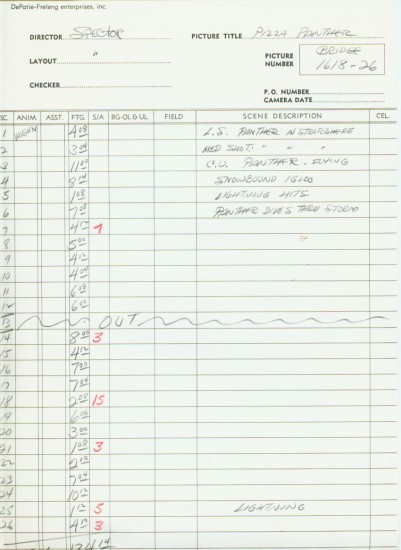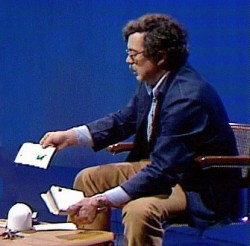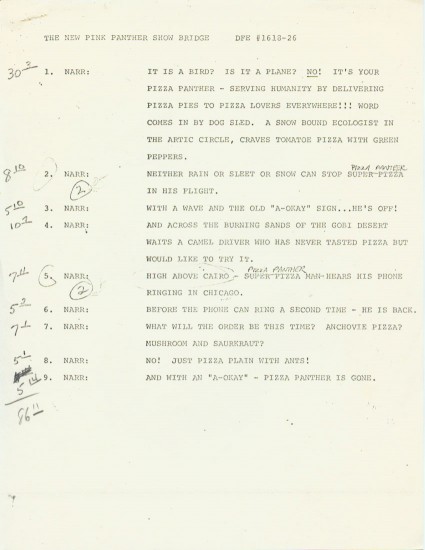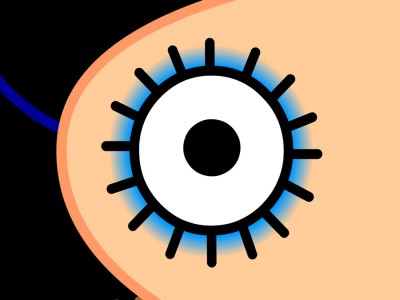Animation Artifacts &Daily post &Independent Animation 07 Mar 2009 08:55 am
Flow charts and Robert Breer
- After my several posts on Exposure sheets, I am planning to write a short piece on the scene folders used at the various studios. These, in a way, are works of art in their own right.
However, Paul Spector sent me something that I talked about quite a while back. When a short or a longform film is done, the amount of paperwork that’s prepared to keep things organized becomes immense. There’s an awful lot of bookkeeping.
All the scenes get numbered, all the sequences get numbered, all the drawings get numbered to correspond to the scene and sequence numbers.
With all those sequences and scenes, you start needing a chart to be able to tell one from the other. Disney’s “Drafts” are a precursor to these. This is what Paul’s sent from his father, Irv Spector‘s collection. It’s a flow chart for some scenes from a Pink Panther short done for DePatie-Freleng. The corresponding page of the script is posted below it.
It looks like they ran out of scene descriptions in the heat of the production and just concentrated on the numbering. John Hubley, I remember, as being the absolute best for scene descriptions. One or two words would completely capture the scene. In the Carousel feature, there were hundreds of scenes, yet you could always tell one from the other. The chart wasn’t done on 8½x11 or 14, but was done by hand on oaktag and pasted in the main I&P room. Using that one or two word caption, you could synthesize the scene you were searching for, and it made a lot more sense than searching for scene C129a or whatever.

(Click any image to enlarge.)
Thanks to Paul Spector for this great example of a flow chart.
__________________________
Tonight!
Don’t forget that Sita Sings the Blues is on ch 13 tonight
in the New York area at 10:45pm.
__________________________
- And now for something completely different.
The Animated World of Robert Breer
Sunday, March 15, 2009, 10:30 a.m.
At The Noguchi Museum
 This free event for children between the ages of 2 and 12 and their families, features an hour-long program of short films by artist and filmmaker Robert Breer followed by art-making activities. Breer, who has been at the forefront of American avant-garde cinema since the 1960s, is a painter and sculptor who turned to animation to create a unique and amazing body of work. Introduced by David Schwartz, Moving Image Chief Curator, Breer’s playful and lively films will engage the entire family and provide a new point of entry from which to view and explore Isamu Noguchi’s work. Following the screening, Noguchi Museum educators will be present to facilitate activities and art-making projects. Families are encouraged to bring a snack and kick back while they enjoy the films. See below for a full list of titles.
This free event for children between the ages of 2 and 12 and their families, features an hour-long program of short films by artist and filmmaker Robert Breer followed by art-making activities. Breer, who has been at the forefront of American avant-garde cinema since the 1960s, is a painter and sculptor who turned to animation to create a unique and amazing body of work. Introduced by David Schwartz, Moving Image Chief Curator, Breer’s playful and lively films will engage the entire family and provide a new point of entry from which to view and explore Isamu Noguchi’s work. Following the screening, Noguchi Museum educators will be present to facilitate activities and art-making projects. Families are encouraged to bring a snack and kick back while they enjoy the films. See below for a full list of titles.
Free admission, but reservations are required. To register, send an email to: smurphy@noguchi.org with your family’s name, the number of attendees and preferred form of contact (phone or email) or call 718.204.7088, extension 203.
The Noguchi Museum is located at Vernon Boulevard between 10th St and 33rd Rd in Long Island City. Sunday shuttle-bus service is available between Manhattan and the Museum.
The following films will be screened:
- Homage To Jean Tinguely’s Homage To New York (1960, 9 mins.) This record of the birth and death of Tinguely’s famous auto-destructive sculpture at MoMA is itself a sculptural work, through its camera and editing techniques.
Fuji (1973, 8 mins.) Rotoscoped images of Mount Fuji, as seen from a train, are blended into the magical dreamscape of this lyrical voyage.
Swiss Army Knife With Rats and Pigeons (1981, 6 mins.) Images from everyday life are intercut with abstract and imaginary shapes in this virtuoso collage of drawings and live action photography.
Bang! (1986, 10 mins.) TV images of a boy paddling a boat, an arena crowd cheering, flowers, phones, and a wide array of personal doodle, photos, and assorted images whiz by in this mayhem-filled gem.
ATOZ (2000, 5 mins.) In this film dedicated to his daughter, Breer uses humor—along with a frog, planes, and other shapes—to look at the impact of the ordered alphabet on a child’s awakening mind.
Trial Balloons (1982, 5 mins.) One of Breer’s most lyrical films, Trial Balloons combines home movies with animation and hand-cut traveling mattes.
What Goes Up (2000, 4 mins.) The richness and the impermanence of life are captured in this rapid-fire animation of images capturing the joys of family and work life, and of food, drink, nature, and love.



on 07 Mar 2009 at 10:20 pm 1.George Griffin said …
“Completely different” indeed! Breer is the animator who never used an exposure sheet because he made it up spontaneously under the camera where he often drew the next frame or shot something from the margin, or randomly on a whim, to make a collage or mash-up. That unforgiving exposure sheet is so critical for animation that’s married to a pre-recorded track. Breer puts visual play first.
on 26 Mar 2009 at 6:26 pm 2.robin said …
for those of you who missed it, Sita is online–the whole thing!…
http://www.thirteen.org/sites/reel13/indies/indie-sita-sings-the-blues/241/